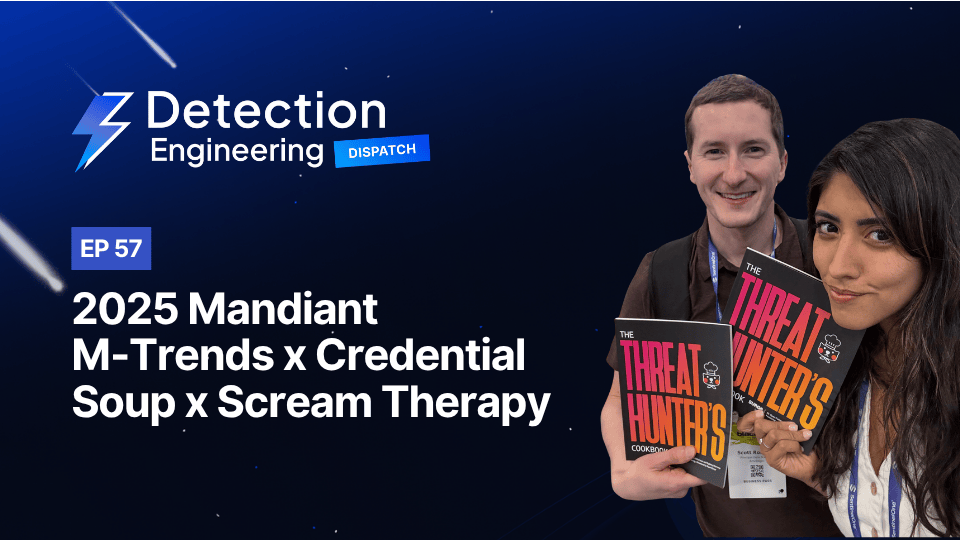Malware Trends, Credential Soup and Scream Therapy
October 30, 2025
Get the GiveawayAlex and Scott Rodgers unpack the F5 breach, Mandiant M-Trends highlights like the fall of BEACON, and the leapfrogging of Stolen Creds over Phishing. Hit play. Stay unhinged. Detect responsibly.
Expect:
- The infostealer industrial complex
- Operation MORPHEUS x BEACON’s quiet exit
- The real meaning of “supply chain blast radius” & tight turnaround time reqs
- Why screaming might actually save your sanity
.png)


Malware Trends, Credential Soup and Scream Therapy
Alex (00:03.701)
Scott, I’ve been on the road nonstop with the launch...bottling up emotions, fighting with friends, go-go-go. But we’re back with Detection Dispatch, your no-BS breakdown of what’s actually happening in SecOps. Today, we’re diving into:
- The F5 breach
- The rise of infostealers
- Beacon’s downfall
- Why stolen credentials have leapfrogged phishing
Joining me is Scott Rodgers, who last broke down prompt injection attacks and recently presented on LLMs in alert triage at Blue Team Con. Scott—what’ve you been up to?
Scott Rodgers (01:52.258)
At Blue Team Con, Kevin Gonzalez and I presented on using LLMs to analyze alerts. The key takeaway: just because you can use an LLM doesn’t mean you should. Tools like NER or regex still have their place—and scale better for some problems.
Alex (02:10.518)
Exactly. Your breakdown of when not to use LLMs really landed. Let’s get into the M-Trends 2024 Report, but first—the F5 breach on October 15th. Scott, what happened?
F5 Breach: What We Know
Scott Rodgers (05:02.210)
F5 suffered long-term persistent access. Attackers accessed Big-IP source code, vulnerability info, and config data. CISA issued an emergency directive—patch by October 22nd. That tells you how serious this is.
Alex (06:09.036)
Especially since F5 is heavily used in federal environments. They had to report directly to CISA.
Scott Rodgers (06:55.766)
We advised customers to monitor logs from Big-IP appliances. F5 released a threat hunting guide. Our team also pushed out prebuilt detections for customers.
AWS | US‑East‑1
Alex (07:24.388)
The AWS outage this week really knocked my tech stack. Not a cyberattack—but raises questions about single-vendor concentration risk.
Scott Rodgers (07:45.112)
Cloud redundancy helps—multi-region, multi-cloud setups—but complexity becomes a factor fast.
M-Trends 2024: Detection Engineering Insights
Alex (08:00.564)
Let’s talk about what really matters: malware trends from frontline incident response data—not surveys.
1. Credentials Overtake Phishing
Alex (09:14.519)
In 2024, stolen credentials surpassed phishing as a top initial access vector. Credential-based attacks are now more common than email phishing. This includes:
- Infostealers
- Keyloggers
- Credential reuse
Scott Rodgers (09:28.494)
Right. The rise of infostealers directly contributes. They're fast, scalable, and don’t rely on social engineering.
Alex (10:07.638)
Time to double down on MFA and build better detections around credential misuse.
2. Phishing Is Quietly Declining
Alex (11:10.0)
Phishing dropped steadily—22% to 14% over three years. Meanwhile:
- Credential-based access rose from 10% to 16%
- Web compromise nearly doubled
Detection teams need to update their playbooks. It’s not always phishing-first anymore.
Scott Rodgers (12:14.7)
And that’s where IAM logs and identity-centric detections come in. They’re tough, but critical.
3. Logging Gaps: A Major Blind Spot
Scott Rodgers (13:15.520)
Mandiant couldn’t determine the initial vector in 34% of incidents due to lack of telemetry. That’s a huge opportunity for improvement.
4. Who Detects First: Internal vs. External
Scott Rodgers (14:22.916)
Back in 2011, 94% of compromises were caught internally. Today? Only 60%. External sources—government, vendors—now catch 40% of incidents.
Alex (15:11.628)
More reason to invest in internal threat hunting and detection engineering. Find it before someone else does.
5. Dwell Time: Still Too High
Scott Rodgers (16:53.900)
Internally discovered attacks: 10 days dwell time.
Externally discovered attacks: 26 days.
Attackers don’t wait—detection speed still matters.
6. Malware Trends: Beacon Drops
Alex (17:07.692)
Beacon usage dropped from 28% to 5%, thanks to Operation Morpheus, which disrupted illicit Cobalt Strike infrastructure. Tools aren’t retired—they’re replaced when defenders catch up.
7. Threat Group Growth
Alex (20:12.868)
Mandiant observed:
- 737 new threat clusters
- 233 were active in engagements
- Most were unknown or criminal groups, not state-sponsored
8. New APTs: Sandworm and DPRK
Alex (25:36.897)
Two groups got promoted:
- APT44 (Sandworm): Known for NotPetya, Ukraine power grid takedowns
- APT45 (DPRK-linked): Financially motivated, possible link to job fraud campaigns
9. Cloud Compromise Trends
Alex (28:28.932)
Top cloud intrusion vectors:
- Phishing (39%)
- Stolen credentials (35%)
- Web compromise (14%)
Scott Rodgers (29:09.710)
Cloud logging is still weak. Many actions don’t generate logs. Bring in red teams to test visibility gaps.
10. MITRE Techniques: What Attackers Actually Use
Scott Rodgers (31:31.086)
Attackers used 71% of MITRE ATT&CK techniques and 40% of sub-techniques. That’s been steady for years.
Focus on what’s consistently abused. Top techniques:
- T1059 – Command/Scripting
- T1027 – Obfuscation
- T1021 – Remote Services
- T1083 – Discovery
- T1070 – Indicator Removal
Alex (34:56.868)
PowerShell still rules the sub-techniques. This is living off the land detection—harder to spot, but essential to track.
11. Top Targeted Industries
Alex (39:16.548)
Most targeted sectors:
- Financial Services (17%)
- Tech
- Healthcare
- Government
Scott Rodgers (40:29.218)
No surprise. Money and espionage still drive the majority of attacks.
SecOps Burnout & Scream Therapy
Alex (35:33.625)
Rough SOC day? Try scream therapy. It works. Just scream into a pillow—it’s cheaper than floating in the Dead Sea.
Scott Rodgers (37:23.459)
Sensory deprivation tanks are great too. Quiet, meditative reset. But yes—screaming might be more accessible.
Final Thoughts
Alex (41:57.506)
We covered a lot—credential soup, supply chain breaches, threat trends, and even therapy hacks. Scott, you always bring the calm to the chaos.
Scott Rodgers (43:03.148)
Thanks for having me. Always a great time.


.svg)


.png)
.png)
.png)